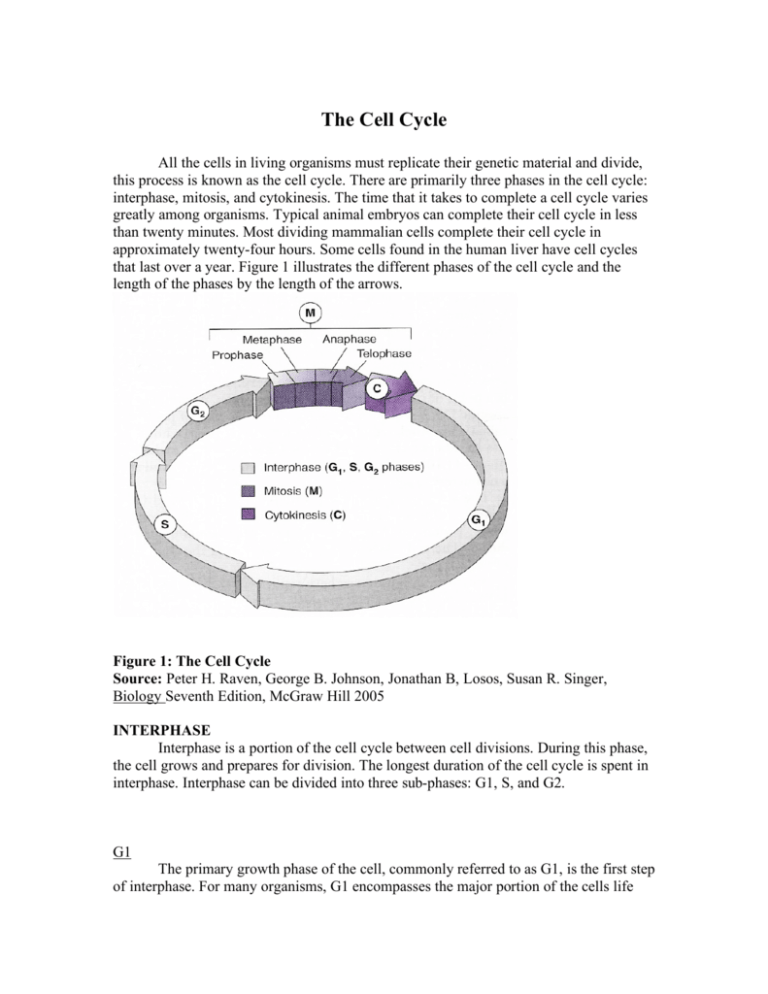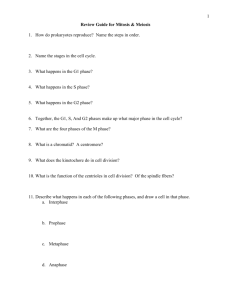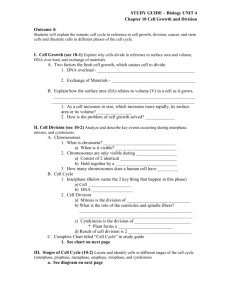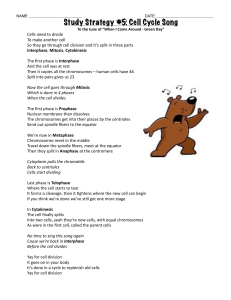"The Cell Cycle," Tanna LeAnn Parks
advertisement

The Cell Cycle All the cells in living organisms must replicate their genetic material and divide, this process is known as the cell cycle. There are primarily three phases in the cell cycle: interphase, mitosis, and cytokinesis. The time that it takes to complete a cell cycle varies greatly among organisms. Typical animal embryos can complete their cell cycle in less than twenty minutes. Most dividing mammalian cells complete their cell cycle in approximately twenty-four hours. Some cells found in the human liver have cell cycles that last over a year. Figure 1 illustrates the different phases of the cell cycle and the length of the phases by the length of the arrows. Figure 1: The Cell Cycle Source: Peter H. Raven, George B. Johnson, Jonathan B, Losos, Susan R. Singer, Biology Seventh Edition, McGraw Hill 2005 INTERPHASE Interphase is a portion of the cell cycle between cell divisions. During this phase, the cell grows and prepares for division. The longest duration of the cell cycle is spent in interphase. Interphase can be divided into three sub-phases: G1, S, and G2. G1 The primary growth phase of the cell, commonly referred to as G1, is the first step of interphase. For many organisms, G1 encompasses the major portion of the cells life span. During G1, cells undergo the major portion of their growth, and the chromosomes in the nucleus prepare to divide. Chromosomes are the genetic material of cells, and they must be replicated for the cell cycle to occur. S S phase refers to the phase in which the cell synthesizes a replica of the genome. This is when the chromosomes are replicated. During the S phase, each chromosome replicates to produce two sister chromatids, which remain attached together. Sister chromatids are exact copies of each other and they play an important role in later phases of the cell cycle. G2 G2 is the second growth phase during interphase. During this phase, organelles inside the cell replicate, chromosomes condense in preparation for the next phase of the cell cycle, and microtubules begin to assemble. Organelles are specialized parts of cells and are located within the cell. Microtubules are long, hollow, protein cylinders that influence cell shape and move the chromosomes in cell division. MITOSIS Mitosis is the second phase of the cell cycle. The primary function of mitosis is for the cell to undergo nuclear division in which the duplicated chromosomes separate to form two identical daughter cells. Mitosis has four sub-phases: prophase, metaphase, anaphase, and telophase. Prophase During prophase, the nuclear membrane disappears and the nucleolus disappears. The nucleolus is what contains the chromosomes. The chromosomes are now able to condense, and the microtubules prepare to move the condensed chromosomes. Metaphase In metaphase, the chromosomes line up along the metaphase plate at the equator of the cell. At this point the microtubules are attached to the chromosomes and are ready to move the chromosomes. Anaphase During anaphase, the microtubules shorten that are attached to opposite sides of the chromosomes and therefore pull them apart. Now the chromosomes are cut in half, and pulled to opposite poles of the cell to complete the cell cycle. Telophase At the point when the cell reaches telophase, the chromosomes reach the poles of the cell. In telophase, the nuclear membrane reforms and the nucleolus reappears. The chromosomes decondense and the cells prepare to divide. CYTOKINESIS Cytokinesis is the final stage of the cell cycle. During cytokinesis, the cell separates into two separate cells. A cleavage furrow forms at the equator of the cell and pinches inward until the cell divides into two separate cells. At this point, the cell cycle is complete and the two daughter cells begin their own cell cycle and will replicate their genetic material and divide as well. The cell cycle must occur for living organisms to survive. It is a complex cycle that cells constantly undertake. There are many controls and checkpoints throughout the cycle to assure proper genetic material replication and cell division. If at any point the cycle fails to function normally, the cell will undergo apoptosis which is cell death. The cell will kill itself to prevent tragic outcomes such as cancer. All cells must go through interphase, mitosis, and cytokinesis.








